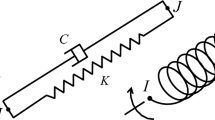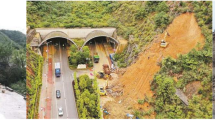Abstract
To investigate the seismic performance of simulated subway tunnels under complex geological conditions of obliquely incident earthquake excitations, a new input method for oblique incidence of SV waves with arbitrary incident angles in 3D space has been proposed. The method relies on explicit finite element method (EFEM) and viscous-spring artificial boundary (VSAB) condition, which simultaneously considers soil-structure interaction, surrounding soil characteristics, and seismic wave incident characteristics. It is applied and verified based on the seismic wave theory. The overall numerical model of subway tunnel and soil foundation is then established, and the dynamic response of subway tunnel in soft and hard interbedded soils under oblique incidence of SV waves is systematically analyzed. The obtained simulated results indicate that the dynamic response of each point in subway tunnel is decreased by increasing incident SV wave angle. It is also found that the dynamic responses of the site interbedded by soft and hard soils are significantly higher than that in other points of the site at the same incident angle, indicating that the mentioned zone has weak seismic resistance. In addition, the dynamic response of each point in tunnel structure tends to become closer when the bulk moduli of soft and hard soils are getting close. The displacement and moment of the site interbedded by soft and hard soils are reduced by increasing the thickness of lining structure, therefore improving the seismic resistance of the tunnel. The results of parametric study show that these factors could have significant influences on the seismic responses of tunnel structures during earthquake and should be considered during earthquake-resistant design of subway tunnels under complex geological conditions.









Similar content being viewed by others
References
Anastasopoulos I, Gerolymos N, Drosos V, Georgarakos T, Kourkoulis R, Gazetas G (2008) Behaviour of deep immersed tunnel under combined normal fault rupture deformation and subsequent seismic shaking. B Earthq Eng 6(2):213–239
Ba ZN, Liang JW, Ren QQ (2012) 3-D scattering of obliquely incident plane P waves by alluvial valley embedded in layered half-space. Transact Tianjin Univ 18(5):356–364
Dowding CH, Rozen A (1978) Damage to rock tunnels from earthquake shaking. J Geotech Eng Div ASCE 104(GT2):175–191
Du X (2009) Theories and methods of wave motion for engineering. Science Press, Beijing, pp 15–21
Du XL, Chen W, Li L (2007) Preliminary study of time-domain seismic response for underground structures to obliquely incident seismic waves. Tech Earthq Disaster Prev 2(3):290–296
Du XL, Huang JQ, Zhao M (2014) Effect of oblique incidence of SV waves on seismic response of portal sections of rock tunnels. Chin J Geotech Eng 36(8):1400–1406
Gao B, Wang ZZ (2009) Lessons learnt from damage of highway tunnels in Wen chuan earthquake. J Southw Jiaotong Univ 44(3):336–343
Gao XJ, Qian H, Wang F (2016) Seismic response analysis of GRPS embankment under oblique incident P wave. J Cent South Univ 23:721–728
Gao XJ (2018) Seismic response of subway tunnels in complicated geological conditions to an oblique incident wave. Modern Tunneling Technol 55(1):78–83
Gao XJ, Duan PH, Qian H (2020) Dynamic response analysis of long-span continuous bridge considering the effect of train speeds and earthquakes. Int J Struct Stab Dyn 20(13):1–20
He C, Zhang J, Li L (2014) Seismic damages mechanism of tunnels through fault zones. Chin J Geotech Eng 3:427–434
He CH, Wang JT, Zhang CH, Jin F (2015) Simulation of broadband seismic ground motions at dam canyons by using a deterministic numerical approach. Soil Dyn Earthq Eng 76:136–144
He CH, Wang JT, Zhang CH (2016) Nonlinear spectral-element method for 3D seismic-wave propagation. B Seismol Soc Am 106(3):1074–1087
He CH, Zhang J, Feng K (2017) Research on structure analysis method of shield tunnel. China J Highway Transport 30(8):1–14
Huang Y (2009) Study on seismic response and shock absorption measures of the typical parts and weak links in the tunnel. Chongqing Jiaotong University, Chongqing
Kazuhide Y, Yoshiyuki K, Mitsuru S et al (2007) Historical earthquake damage to tunnels in Japan and case studies of railway tunnels in the 2004 Niigataken Chuetsu Earthquake. Qr Rtri 48(3):136–141
Kwok AOL, Stewart JP, Hashash YMA (2008) Nonlinear ground-response analysis of Turkey Flat shallow stiff-soil site to strong ground motion. B Seismol Soc Am 98(1):331–343
Li XJ (1993) Study on the method of analyzing the earthquake response of nonlinear site. Institute of Engineering Mechanics, China Earthquake Administration, Harbin
Liao ZH P (2002) Introduction to wave motion theories in engineering. Science Press.
Sharma S, Judd WR (1991) Underground opening damage from earthquakes. Eng Geol 30:263–276
Sui CY, Gao B, Shen YS (2017) Shaking table tests and analysis for fault-crossing tunnels with multi anti-seismic structures. J China Railway Soc 39(11):124–130
Takahiro S (2000) Estimation of earthquake motion incident angle at rock site. Proceeding of 12th World Conference Earthquake Engineering, New Zealand, p 956
Tsaur DH, Chang KH, Hsu MS (2018) Ground motions around a deep semielliptic canyon with a horizontal edge subjected to incident plane SH waves. J Seismol 22(6):1579–1593
Wang DG, Shi PX, Zhao CG (2019) Two dimensional in plane seismic response of long span bridges under oblique P wave incidence. B Earthq Eng 17(9):5073–5099
Wang WL, Wang TT, Su J (2001) Assessment of damage in mountain tunnels due to the Taiwan Chi-Chi Earthquake. Tunn Undergr Sp Tech 16:133–150
Wang ZH, Zhao CG (2009) Viscous-spring dynamic artificial boundaries and wave motion inputs for transient analysis of saturated porous medium. Comput Geotech 36(1):199–210
Wang W, He CH, Geng P (2016) Longitudinal aseismic analysis of shield tunnels in inhomogeneous ground. Modern Tunn Tech 53(6):73–79
Yang Z, Jian CL, Jian Z (2019) A novel experimental method to investigate the seismic response of rock joints under obliquely incident wave. Rock Mech Rock Eng 20(2):1–8
Yao Y, Liu TY, Zhang JM (2016) A new series solution method for two-dimensional elastic scattering by a canyon in half-space. Soil Dyn Earthq Eng 89:128–135
Zhang N, Gao Y, Wu Y, Zhang F (2018) A note on near-field site amplification effects of ground motion from a radially inhomogeneous valley. Earthq Eng Eng Vib 17(4):707–718
Funding
This work was financially supported by the National Science Foundation of China (NSFC) under Grant Nos. 41602297 and 51909241, the Scientific Research Key Project Fund of Colleges and Universities of Henan Province under Grant No. 14A560014, the China Postdoctoral Science Foundation under Grant No. 2018M632806, and the Key Scientific and Technological Project of Henan Province under Grant No. 182102310009. The authors are grateful for their continuous supports.
Author information
Authors and Affiliations
Corresponding author
Ethics declarations
Conflict of interest
The authors declare that they have no competing interests.
Additional information
Responsible Editor: Narasimman Sundararajan
Rights and permissions
About this article
Cite this article
Gao, X., Duan, P. & Duan, S. Simulated seismic response analysis of subway tunnels under complex geological conditions of obliquely incident seismic SV waves. Arab J Geosci 14, 992 (2021). https://doi.org/10.1007/s12517-021-07376-w
Received:
Accepted:
Published:
DOI: https://doi.org/10.1007/s12517-021-07376-w




